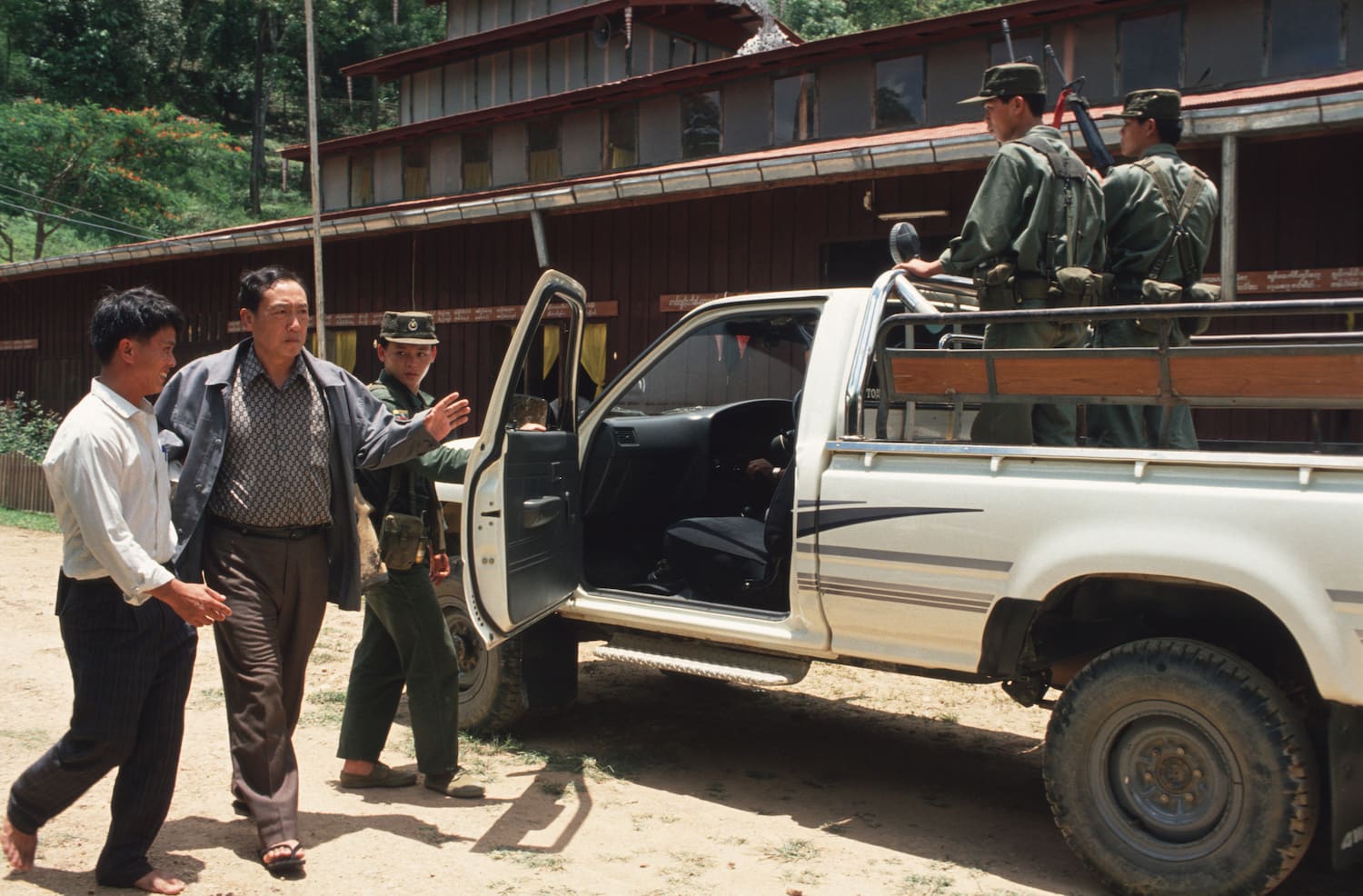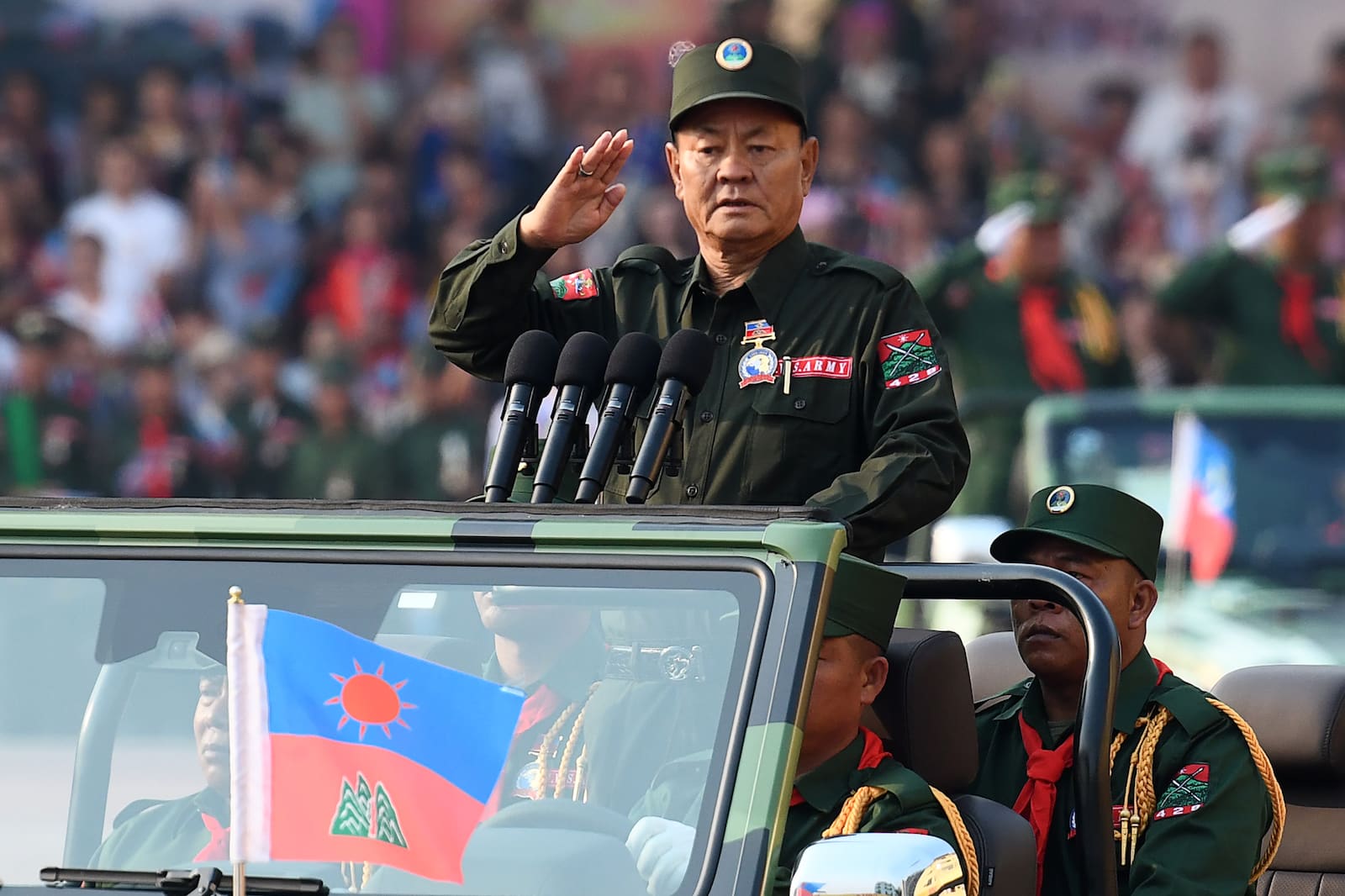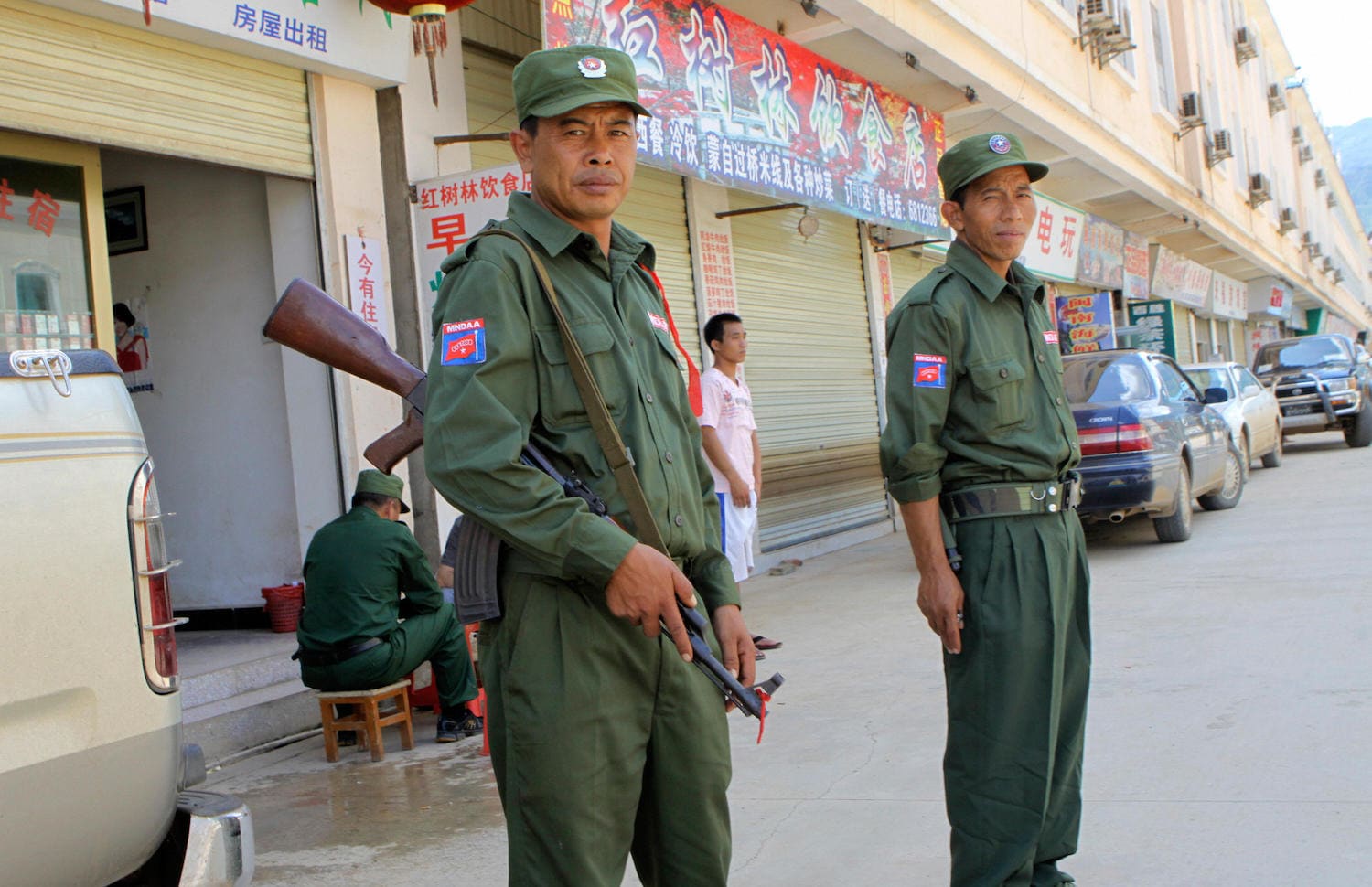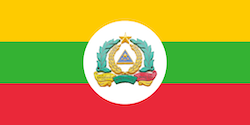Northeast Myanmar: three axes of conflict
In northeast Myanmar, the coup has transformed protracted armed conflicts and the war economies they have produced. The conflict in this part of Myanmar is not simply between the Tatmadaw and its opponents, as the coup has reignited tensions between ethnic armed organisations (EAOs).
Graphics by Brody Smith
Edited by Aaron Connelly

Northeast Myanmar is a mosaic of overlapping ethnonational movements, counter-insurgency campaigns, local militias and war economies. Civilians in some areas are subject to the regular presence of multiple armies – including the Tatmadaw, local militias and a variety of ethnonational fronts, representing Shan, Kachin, Ta’ang (or Palaung) and Wa populations – while others live in zones administered predominantly by one ethnic armed organisation. Since Myanmar’s independence from British rule in 1948, few, if any, parts of Shan and Kachin states have known control by the central government alone.
1 Feb 2021 to 31 July 2022
* = excluding KIO
Most northeastern ethnic armed organisations (EAOs) have denounced the coup and clashed with the Tatmadaw, but are not coordinating their strategy with the wider anti-coup resistance. A significant exception is the Kachin Independence Organisation (KIO), which has urged all groups fighting the State Administration Council (SAC) junta to support the shadow National Unity Government (NUG). As such, People’s Defence Forces (PDF), which are anti-SAC armed groups formed after the coup, are not a dominant force in this warscape – except in some parts of Kachin State and on the borders between northeast Myanmar and the Dry Zone, where the KIO has a strong presence. The northeast has also seen conflict between two armed groups which position themselves as standard-bearers for Shan ethnonationalism: the Restoration Council of Shan State (RCSS) and the Shan State Progress Party (SSPP).
Simultaneous conflict along three axes – between the SAC and EAOs aligned with the NUG, between the SAC and EAOs unaligned with the NUG, and amongst EAOs – makes the northeast unique among Myanmar’s six warscapes. A review of the origins of armed groups in the area helps to explain these dynamics.
The origins of fragmented sovereignties
Northeast Myanmar was a restive place long before the coup, home to numerous insurgencies fighting the Myanmar nation-state. In the late 1940s, the Chinese nationalist Kuomintang retreated from Yunnan to Shan State, where 12,000 Kuomintang troops took refuge following their defeat by the People’s Liberation Army. While opium had been cultivated in the Shan uplands for decades, the Kuomintang’s presence created a thicker network of opium cultivators, workers and traffickers so that the organisation could sustain itself. At the same time, the Communist Party of Burma (CPB) was pushed out of cities, after which it began to regroup in the Shan hills. There, the CPB could access cross-border support from the Chinese Communist Party in its fight against both the Kuomintang and the Burmese government in Rangoon. By 1961, most Kuomintang troops had been pushed out of Myanmar and into northern Thailand, but the CPB’s insurgency profoundly shaped conflict in northeast Myanmar until the party’s demise in the late 1980s.
In the late 1950s and 1960s, new EAOs launched rebellions against the central government from bases in northeast Myanmar. They were acting out of a growing sense of frustration that the Rangoon government had become increasingly centralised and dismissive towards the demands of minority groups. The first insurgents to seek Shan autonomy declared war against the central government in 1958, calling themselves Num Suk Han (‘Brave Young Warriors’). Based near the Thai border, a faction of Num Suk Han formed the Shan State Independence Army in 1960. In 1964, this army merged with two other resistance movements to form the Shan State Army, which established a political wing, the SSPP, five years later. Another significant EAO to emerge in this period was the Kachin Independence Organisation (KIO) in 1961, from a broad coalition of Kachin people frustrated at the central government’s insistence on pushing Buddhism and the Burmese language onto the country’s minorities. Over the next two decades, the KIO expanded across Kachin State and northern Shan State. In 1963, the first Ta’ang resistance movement was founded under the banner of the Palaung National Force – a predecessor to the Ta’ang National Liberation Army (TNLA). The SSPP, KIO and TNLA are still significant ethnonational fronts today.

Myanmar’s 1962 coup – which heralded 49 years of near-continuous junta rule – contributed to further militarisation in the northeast. The incipient military government sought ‘national unity’ by eliminating ‘threats posed by insurgents.’ This resulted in the creation of more armed groups, as the Tatmadaw relied on self-financing proxy militias as part of its efforts to pacify northeast Myanmar. In practice, this strategy introduced more instability to the area. For one, cycles of insurgency and counter-insurgency kept remote local populations impoverished, making them amenable to participation in armed groups and the opium trade. In addition, the Tatmadaw’s use of proxy militias inadvertently empowered strongmen who later became drug kingpins. These militias, which the Tatmadaw had granted impunity in exchange for supporting its counter-insurgency campaigns, used drugs to finance their operations. One estimate noted that by 1973, militias were transporting over 95% of Shan State’s opium.
Khun Sa – one of Southeast Asia’s most notorious drug lords – amassed power as the leader of a Tatmadaw proxy, the Loi Maw Militia. He renamed this force the Shan United Army in 1964, from whence Khun Sa, who was of mixed Chinese–Shan–Palaung heritage, began to portray himself as a flagbearer for Shan ethnonationalism. In 1985, Khun Sa merged his force with the Shan United Revolutionary Army (SURA), to form the Mong Tai Army. Unlike Khun Sa’s Shan United Army, SURA had never been a Tatmadaw proxy militia. SURA’s leader, Kawn Song (also known as Mo Heng), had been part of the CPB, Num Serk Han and the Shan State Army – all of which were avowedly antagonistic towards the Tatmadaw – before deciding to chart his own path to Shan independence.

Founded in 1969, SURA envisioned a Shan-led, Buddhist and anti-communist Shanland. But SURA – which had allied with the Kuomintang – eventually joined the Mong Tai Army when the Kuomintang’s power waned, thereby combining Khun Sa’s economic and military might with SURA’s robust emphasis on consolidating Shan ethnonationalism, such as through the promotion of Shan literacy. For a decade, Khun Sa’s Mong Tai Army expanded northeast Myanmar’s illicit economies, eventually becoming the most formidable non-governmental armed force in the region.
Ceasefires and conflict after the Cold War
In 1989, conflicts in northeast Myanmar became – at least superficially – organised along ethnic lines, when mutinying troops stormed the CPB’s headquarters. Several factors contributed to the mutiny and the CPB’s resultant collapse: soldiers’ frustrations with their autocratic leaders, an unpopular crackdown on cadres’ involvement in the drug trade, and ethnic tensions between the CPB’s Bamar leaders and its diverse rank and file. The CPB fragmented into several armed groups, the largest of which became the United Wa State Army (UWSA), an EAO associated with the Wa ethnic group. The UWSA quickly agreed to a ceasefire with the Tatmadaw, in exchange for autonomous territories. Today, the Tatmadaw recognises the UWSA’s control over two non-contiguous areas: the ‘Wa Self-Administered Division’ on the Chinese border, later recognised under Myanmar’s 2008 constitution, and the ‘171 Military Region’ on the Thai border, which is not constitutionally recognised.
Three other CPB splinter groups were also granted self-administered zones in exchange for ceasefires around the same time: the Myanmar National Democratic Alliance Army (MNDAA), the National Democratic Alliance Army (NDAA) and the New Democratic Army – Kachin (NDA-K). Two decades later, the NDA-K became a Tatmadaw proxy under the junta’s Border Guard Force (BGF) scheme. Among other things, becoming a BGF meant that NDA-K members would receive the same salaries and benefits as Tatmadaw soldiers. In exchange, the NDA-K would incorporate Tatmadaw soldiers in its ranks.



After reaching ceasefire agreements with CPB splinter groups, the Tatmadaw used the same tactic to pacify other northeastern EAOs. Significant among these were the 1989 SSPP ceasefire and the 1994 ceasefire between the KIO and the Tatmadaw, the latter of which ended three decades of bitter fighting in Kachin State and northern Shan State. The KIO ceasefire, which lasted 17 years, reshaped northeast Myanmar’s conflict economies, just as the Tatmadaw’s proxy militias had in prior decades. The central government granted the KIO the right to exploit vast natural resources in ceasefire areas, resulting in the expansion of logging, rubber production and mining industries. This benefitted both KIO and Tatmadaw elites, but disenfranchised local populations, in a process that has been called ‘ceasefire capitalism.’
Another significant development in northeast Myanmar was Khun Sa’s sudden surrender in early 1996. While presenting itself as a Shan EAO, the Mong Tai Army’s rank and file had questioned Khun Sa’s ethnonationalist credentials due to his reputation as a mercenary, drug lord and dictator. Jane Ferguson documents how, for instance, Khun Sa would execute villagers who failed to meet the Mong Tai Army’s opium delivery quotas, creating the impression that – in a former soldier’s words – Shan people were ‘just pawns in Khun Sa’s game, a bridge for him to walk across to do his drug business.’ Shan nationalists thus worried that he would abandon the cause if tides turned. Their fears were confirmed when, under military pressure from the UWSA, Khun Sa surrendered in exchange for the central government’s protection against his extradition to the United States on drug trafficking charges. Many troops refused to put down their arms and joined existing Shan resistance groups or the new RCSS, formed in 1996. At the same time, the Tatmadaw moved into former Mong Tai Army territories, fearing the rise of a new, unified Shan ethnonationalist movement. The ensuing violence displaced an estimated 300,000 Shan people into Thailand.
The KIO ceasefire and the Mong Tai Army surrender quietened armed conflict in northeast Myanmar for more than a decade, although clashes never entirely ceased. In 2011, two significant events undermined this status quo. For one, Myanmar President Thein Sein’s new quasi-civilian administration pursued peace talks with EAOs, culminating in the 2015 Nationwide Ceasefire Agreement (NCA). While the new administration’s approach quelled conflict in the a southeast – via a ceasefire with the Karen National Union, then Myanmar’s most formidable EAO – Thein Sein’s administration was less successful in placating EAOs in northeast Myanmar, where the RCSS was the only significant EAO to agree to a ceasefire.
In northeast Myanmar, before the coup, the NCA was paradoxically a key source of conflict, as it provoked tensions between signatories and non-signatories
But more importantly, a few months before Thein Sein came to power, the 17-year long KIO–Tatmadaw ceasefire collapsed. Three years prior, the incumbent junta had demanded that ceasefire groups like the KIO become BGFs, effectively transforming them into Tatmadaw proxies. This incensed the Kachin grassroots, many of whom had seen how ceasefire capitalism widened the inequality between themselves and older, profiteering KIO elites. Young, frustrated Kachin leaders drove the KIO back toward conflict. According to the political sociologist David Brenner, this turned Myanmar’s conflict landscape ‘upside down’, as the KIO entered ‘battles more severe than any northern Myanmar [had] seen since the late 1980s.’
Renewed conflict in northeast Myanmar – during a ceasefire period in most other parts of the country – led northeastern EAOs to band together after the NCA isolated them. They also joined forces with the Arakan Army, another NCA non-signatory which, after 2018, became engaged in some of the heaviest fighting Myanmar had seen in decades. Two overlapping military alliances formed, consisting predominantly of northeastern EAOs: the Northern Alliance (the KIA, TNLA, MNDAA and the Arakan Army) and the Brotherhood Alliance (the TNLA, MNDAA and the Arakan Army). In addition, the Federal Political Negotiation and Consultative Committee (FPNCC) formed in 2017. The FPNCC is a seven-member political bloc consisting of non-NCA signatories, encompassing Northern Alliance members, the UWSA, the SSPP and the NDAA. Between the end of 2018 and the coup, both the Tatmadaw and the Northern Alliance declared a series of unilateral ceasefires. However, these did not lessen the fighting and failed to culminate in peace negotiations.







Hence in northeast Myanmar, before the coup, the NCA was paradoxically a key source of conflict, as it provoked tensions between signatories and non-signatories. The NCA emboldened the RCSS, which formed out of the remnants of the Mong Tai Army. The RCSS pushed north from its bases in southern Shan State, near the Thai border, seeking access to highways and a share of trade between China and Myanmar. This increased tensions between the RCSS and two NCA non-signatories based in northern Shan State – the SSPP and TNLA – whose refusal to accede to ceasefires had prompted retaliation from the Tatmadaw. The conflict was further inflamed by rumours that the Tatmadaw was covertly reinforcing the RCSS. In the words of analyst Khun Say Lone, the two Shan EAOs, the RCSS and SSPP, thus went from ‘friends’ to ‘bitter enemies’.
Three axes of conflict in northeast Myanmar
This history is critical to interpreting contemporary conflict dynamics in northeast Myanmar. Since the coup, clashes have occurred along three main axes.
Firstly, the KIO – the only northeastern EAO openly participating in the wider anti-coup resistance – has clashed with SAC forces in Kachin and northern Shan States, with hotspots in Hpakant and Momauk townships. The KIO was one of the first EAOs to denounce the coup via military action. It seized Tatmadaw outposts in Mohnyin and Momauk townships in March 2021 in response to crackdowns against peaceful protesters.
Since then, the KIO has pushed southwards into northern parts of the Dry Zone, where it cooperates with PDFs to cut off the Tatmadaw’s supply lines into Kachin State. According to the analyst Ye Myo Hein, the KIO also has full command over PDFs in Kachin State, which are organised as the Kachin People’s Defence Forces (KPDF). These consist of approximately 5,000 PDF troops. Furthermore, the KIO has worked with Kachin civil society and the NUG to establish de facto federal governance arrangements. In response, the Tatmadaw has retaliated with heavy artillery and airstrikes, displacing 5,000 civilians, in addition to the 97,000 already displaced in Kachin State before the coup. By contrast, the KIO’s base areas along the border between Kachin State and China have remained relatively stable. There have not been any violent events in Nawngmun and Khaunglanhpu, Myanmar’s northernmost townships, since the coup; an exception not only in northeast Myanmar, but countrywide.
Most other northeastern EAOs have been fighting the SAC too, albeit without joining the wider resistance movement. Muse township is the hotspot for this type of conflict, where the TNLA and MNDAA have clashed with SAC forces. Many of these groups have historically been more interested in maintaining their territorial autonomy than pushing for countrywide federal reforms. After the coup, a TNLA spokesperson alluded to its layered set of interests when he stated, ‘one of our ultimate goals is also to overthrow the military regime. But we are doing it our own way’. The TNLA is prioritising its close relationship with the China-backed UWSA – presently Myanmar’s strongest EAO – over participation in countrywide reforms. Indeed, one reason why such EAOs insist on charting their own paths is that they are caught between various interests and alliances. For northeastern EAOs, conflict has never been about reforming the Myanmar nation-state, nor about ethnicity alone. To survive, EAOs must sustain the war economies they are embedded in, the alliances they are a part of, as well as manage local populations who have had little contact with successive central Myanmar governments.
Finally, fighting between EAOs has occurred in central Shan State townships such as Kyaukme, with the RCSS on one side and the TNLA and SSPP (and sometimes the UWSA) on the other. Before the coup, the RCSS, an NCA signatory, had moved into areas claimed by the TNLA and the SSPP – both NCA non-signatories – when the Tatmadaw drove them out. Sporadic fighting between these EAOs thus ensued in 2015, with little success for the TNLA and SSPP until after the coup when, overstretched on other fronts, the Tatmadaw could not prevent the TNLA and SSPP from moving freely throughout northern Shan State. The TNLA and SSPP have now driven the RCSS out of northern Shan State using heavy weapons from the UWSA. The RCSS, having been backed into a corner, is the only significant EAO to have conceded that non-violent ‘dialogue’ with the SAC is the best way to solve Myanmar’s crisis. This represented an about face for Yawd Serk, the RCSS leader, who had denounced the coup prior to the RCSS’ defeats on the battlefield.
It may be tempting to read inter-EAO conflicts as a proxy war between pro- and anti-SAC EAOs. But the decades since Myanmar’s independence have shown that conflicts in northeast Myanmar cannot be understood in binary terms. Rather, successive cycles of insurgency and counter-insurgency have fragmented armed groups and impoverished civilian populations, culminating in a complex, multidimensional conflict. Inter-EAO conflicts should come as no surprise, nor are they a commentary on the success of the anti-coup resistance.
Another critical contextual point is that in northeast Myanmar, fighting between EAOs and the SAC outstrips that between EAOs. It may be compelling to emphasise the inter-EAO conflicts which distinguish northeast Myanmar from other warscapes; however, this is but one facet of a multidimensional conflict.
All violent events in the northeast.
Each square ■ indicates a violent event from 01 Feb 2021 to 31 July 2022
Divide and rule
Before the coup, analysts pointed towards the Tatmadaw’s use of ‘divide and rule’ as a conflict-management strategy in the northeast and elsewhere. Non-inclusive ceasefires had a see-saw effect throughout the country; allowing the Tatmadaw to focus its military might on a select number of opponents, before reopening old fronts once its latest opponents had been subdued. In northeast Myanmar, the see-saw dynamic has played out within a single warscape: by allowing the RCSS to expand north before 2021, the Tatmadaw set the stage for inter-EAO conflicts after the coup. Inter-EAO conflicts drive a wedge between EAOs and keep them preoccupied with local territorial struggles. Besides, northeast Myanmar’s history features few precedents for solidarity between EAOs and wider movements for countrywide reform, as the former have mostly focused on survival amidst emergent militias and shaky ceasefires.
The northeast’s conflict economies have been booming since the coup, as various actors – including the Tatmadaw, EAOs, militias, and local elites – have taken advantage of the power vacuum to expand their business operations. In May 2022, one researcher in Kachin State estimated that gold mining had increased tenfold since the coup. And in August 2022, Global Witness released a report on the unprecedented scale of illegal rare-earths mining in areas of Kachin State controlled by Tatmadaw-linked militias, with exports having more than doubled since the coup. In addition, the narcotics trade in Shan State has also surged, pushing drug prices down in neighbouring countries.
Building unity among anti-coup forces in northeast Myanmar is thus an uphill task for those opposed to military rule, which requires confronting not just the individual interests of various armed groups but also the area’s protracted history of insurgency and counter-insurgency.
In an analysis of the Tatmadaw’s mindset, Andrew Selth argues that ‘narcotics-based armies … offend the generals’ sense of mastery over all Myanmar’s territory’, but are better tolerated than EAOs because they do not directly challenge the central government’s authority. This explains why, overstretched on other fronts in the current conflict, the SAC appears to be turning a blind eye to the upsurge in extraction and trafficking in northeast Myanmar. This may splinter the resistance further: rapacious profiteering has, in the past, fractured emergent ethnonational movements by detaching insurgent elites from their grassroots.
Building unity among anti-coup forces in northeast Myanmar is thus an uphill task for those opposed to military rule, which requires confronting not just the individual interests of various armed groups but also the area’s protracted history of insurgency and counter-insurgency. The northeast is not an undifferentiated zone of lawlessness and chaos, but has been shaped by complex, multidimensional power relations entrenched over decades. Understanding these and charting the path forward, requires that analysts resist reducing violence in the northeast to an ethnicity-based conflict, or a Manichaean struggle between forces ‘for’ or ‘against’ federal democracy.
Dr Shona Loong is a senior scientist in political geography at the University of Zurich, and a non-resident Associate Fellow for Southeast Asian Politics and Foreign Policy at the IISS. Her research focuses on conflict, peacebuilding, and the politics of development in Myanmar and its borderlands.